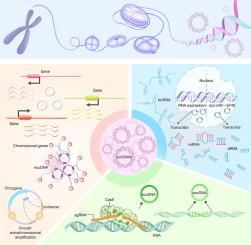超越染色体:探索染色体外环状DNA的多种功能
IF 13
1区 综合性期刊
Q1 MULTIDISCIPLINARY SCIENCES
引用次数: 0
摘要
染色体外环状DNA (extrachrosomal circular DNA, eccDNA)是一种广泛存在于各种生物环境中,独立于染色体结构存在的环状DNA。目前在健康和肿瘤组织中发现的总eccDNA的分布表明,基因组覆盖率从1.18%到30.73%不等。eccdna是双链、共价封闭的环状DNA分子,起源于体细胞重排、基因组不稳定和超转录等机制。EccDNA具有开放的染色质结构,可以参与整个基因组的转录调控,并介导EccDNA之间以及EccDNA与染色体之间的广泛相互作用。eccdna从几十个碱基对到百万碱基(Mb)不等,可能包括从小的非编码序列到整个基因和调控元件的任何东西。目前的研究方法限制了敲除或敲除基因组DNA等eccDNA的能力。过表达单个eccdna也具有挑战性,这使得探索其分子功能变得困难。本文综述了eccDNA未被充分开发的潜在功能,特别强调了其作为增强子的作用及其参与转录mrna和非编码rna (ncRNAs)的产生。此外,我们提供了体外合成eccDNA的方法和基于CRISPR/Cas9技术的细胞内生成eccDNA的方法,为阐明其生物学功能和作用机制提供了研究基础。最后,从前瞻性的角度展望了ecdna的功能机制及其在各种生物场景中的潜在应用前景。本文章由计算机程序翻译,如有差异,请以英文原文为准。

Beyond chromosomes: exploring the diverse functions of extrachromosomal circular DNA
Extrachromosomal circular DNA (eccDNA) is defined as a form of circular DNA that is widespread across various biological contexts and exists independently of chromosomal structures. The current distribution of total eccDNA identified in both healthy and tumor tissues shows genomic coverage ranging from 1.18% to 30.73%. EccDNAs are double-stranded, covalently closed, circular DNA molecules that originate from mechanisms such as somatic rearrangements, genomic instability, and hypertranscription. EccDNA possesses an open chromatin structure, which can participate in transcriptional regulation across the entire genome and mediate extensive interactions between eccDNAs and between eccDNA and chromosomes. EccDNAs vary from a few dozen base pairs to megabases (Mb) and may include anything from small non-coding sequences to entire genes and regulatory elements. Current research methods limit the ability to knock down or knock out eccDNA like genomic DNA. Overexpressing individual eccDNAs is also challenging, making it difficult to explore their molecular function. This review examines the underexplored potential functions of eccDNA, with particular emphasis on its role as an enhancer and its involvement in the production of transcribed mRNAs and non-coding RNAs (ncRNAs). In addition, we provided a method for in vitro synthesis of eccDNA and a method for generating eccDNA in cells based on CRISPR/Cas9 technology, which provides a research foundation for elucidating its biological functions and mechanisms of action. Finally, this paper presents innovative prospects from a forward-looking perspective regarding the functional mechanisms and potential applications of eccDNA in various biological scenarios.
求助全文
通过发布文献求助,成功后即可免费获取论文全文。
去求助
来源期刊

Journal of Advanced Research
Multidisciplinary-Multidisciplinary
CiteScore
21.60
自引率
0.90%
发文量
280
审稿时长
12 weeks
期刊介绍:
Journal of Advanced Research (J. Adv. Res.) is an applied/natural sciences, peer-reviewed journal that focuses on interdisciplinary research. The journal aims to contribute to applied research and knowledge worldwide through the publication of original and high-quality research articles in the fields of Medicine, Pharmaceutical Sciences, Dentistry, Physical Therapy, Veterinary Medicine, and Basic and Biological Sciences.
The following abstracting and indexing services cover the Journal of Advanced Research: PubMed/Medline, Essential Science Indicators, Web of Science, Scopus, PubMed Central, PubMed, Science Citation Index Expanded, Directory of Open Access Journals (DOAJ), and INSPEC.
 求助内容:
求助内容: 应助结果提醒方式:
应助结果提醒方式:


